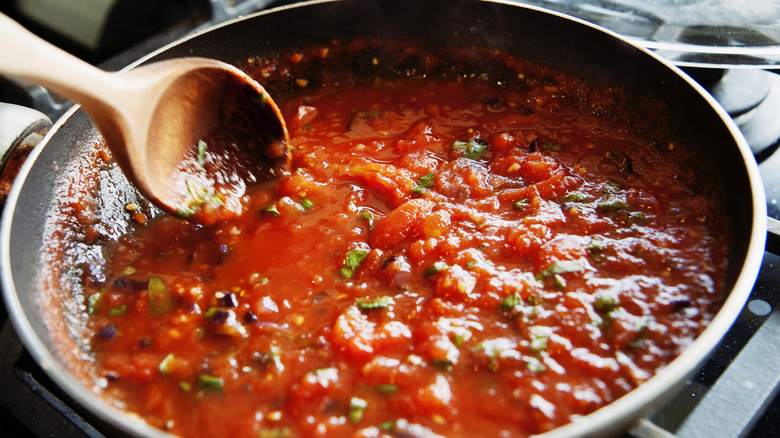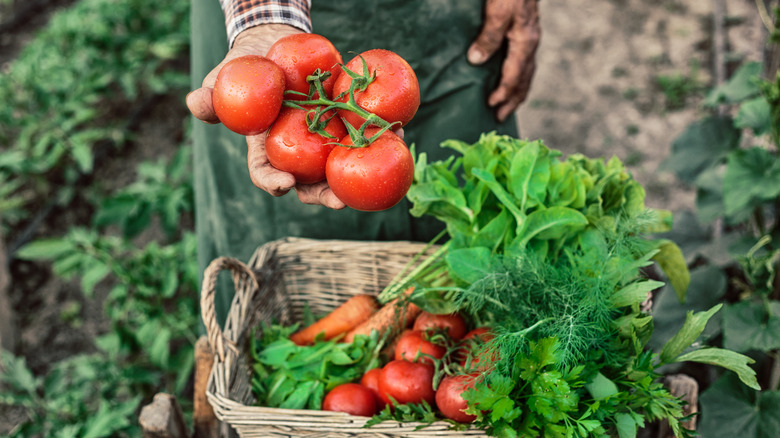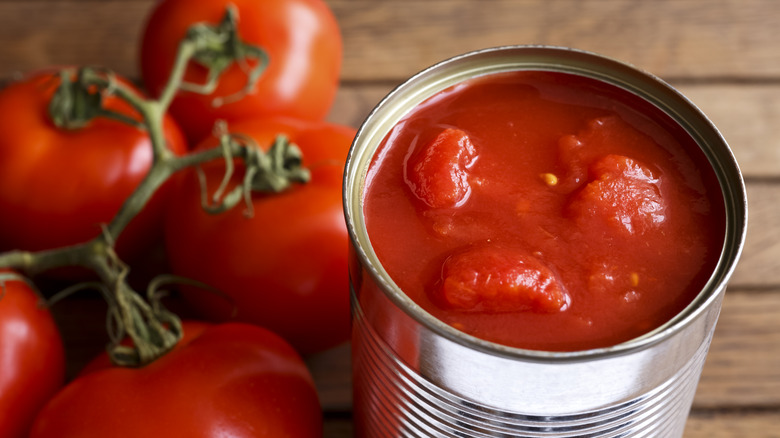The Carrot Trick To Fix Acidic Tomato Sauce
Just about everyone has a method they swear by or a tried-and-true family recipe for the perfect, balanced, all-purpose tomato sauce. Mastering the art of sauce is a task worth taking on, regardless of the recipe you use. Homemade puts store-bought sauce to shame, and it serves as the backbone for delicious pizza and pasta nights, hearty lasagnas, and tomato-based soups. However, a common stumbling block for even the experienced master is winding up with an overly acidic sauce. This can be caused by the tomatoes you start with or a slightly off-balance ratio of seasonings and ingredients. While any good sauce should feature prominent tangs of acidity, they also require the right amount of sweetness to balance the flavors.
Of course, it's not a crime to add a bit of sugar to your sauce (depending on who you ask), but there's a better way that many chefs and expert sauce masters rely on — simply adding carrots into the mix. Not only does this sneak in some extra veggies, plus doses of vitamins and beta-carotene per serving, but cooking your sauce with shredded or very finely chopped carrots helps to thicken the consistency while adding natural sweetness and subtle earthy flavor. You can finely mince, shred on a cheese grater, or even run carrots through a food processor depending on if you want their texture to be detectable in the final sauce or not, then add to the pot with other ingredients and allow it all to simmer down.
Add shredded or whole carrots to your sauce
The trick of adding carrots to your sauce is a nearly foolproof one ... with just a few easy pointers to keep in mind. Firstly, resist overdoing it, as you can easily swing too far in the opposite direction and end up with a cloyingly sweet sauce. Start with just a bit – maybe 1/4 or 1/3 a cup to start — tasting and adding more if needed as you go.
You'll also want to add carrots to the sauce early enough in the process so the added shreds or bits have plenty of time to cook down until they're well incorporated and almost undetectable in the sauce. No one wants to bite into undercooked chunks of texture. You can add carrots early in the cooking process, mixing them in with your tomatoes and sauteed garlic and onions and letting them cook down with all other ingredients until your sauce is well balanced.
Alternatively, if you're not a fan of the root veg, you can even get away with adding whole, washed carrots to the sauce, allowing them to simmer and lend their sweetness to the mix. Then fish out and discard the whole carrot before serving — the sauce will still pick up the veggie's notes of sweetness as it cooks. As far as what type of carrots, any work, even that bag of baby carrots hiding out in the produce drawer. Whether you peel them beforehand or not is optional.
Sauce made with homegrown or canned tomatoes can be too acidic
If you've ever made an almost-right sauce that's decidedly just missing something, you may initially think it needs more salt — but easy does it, as you can add but you can't take back. Spices, extra simmering, and a splash of wine all go a long way, but it's often a bit of sweetness that tomato sauce lacks.
If you're making a sauce with homegrown tomatoes, certain home garden varieties are low in sugar and high in acidity to begin with. Slightly underripe tomatoes can also be the culprit. With canned tomatoes, the majority sold in your supermarket will have added citric acid to aid with the preservation and prolong the lifespan, but added acidity can impact taste (it's why splurging for canned San Marzano tomatoes — prized for their well-balanced flavor — is often worth it). Carrots cut through and round out the acidic base of tomatoes, no matter the type you're using.
Other popular methods for rounding out a too-acidic sauce include hacks like caramelizing onions for the sauce, using a pinch of baking soda, or adding creamy fattiness from sources like a bit of Parmesan cheese or a splash of heavy cream (or your favorite non-dairy substitute.) Of course, while those are all viable options, if a workaround that adds fiber and vitamins without additional calories, fat, extra prep time, or pricy ingredients speaks to you, it's the humble root veg's time to shine.


